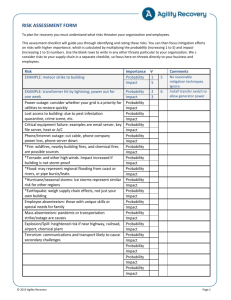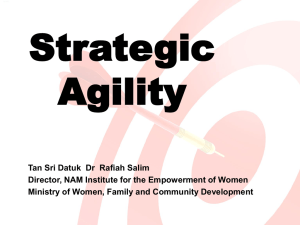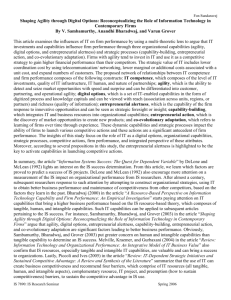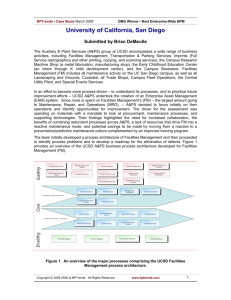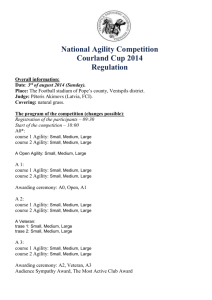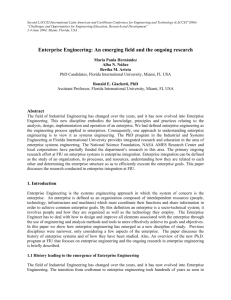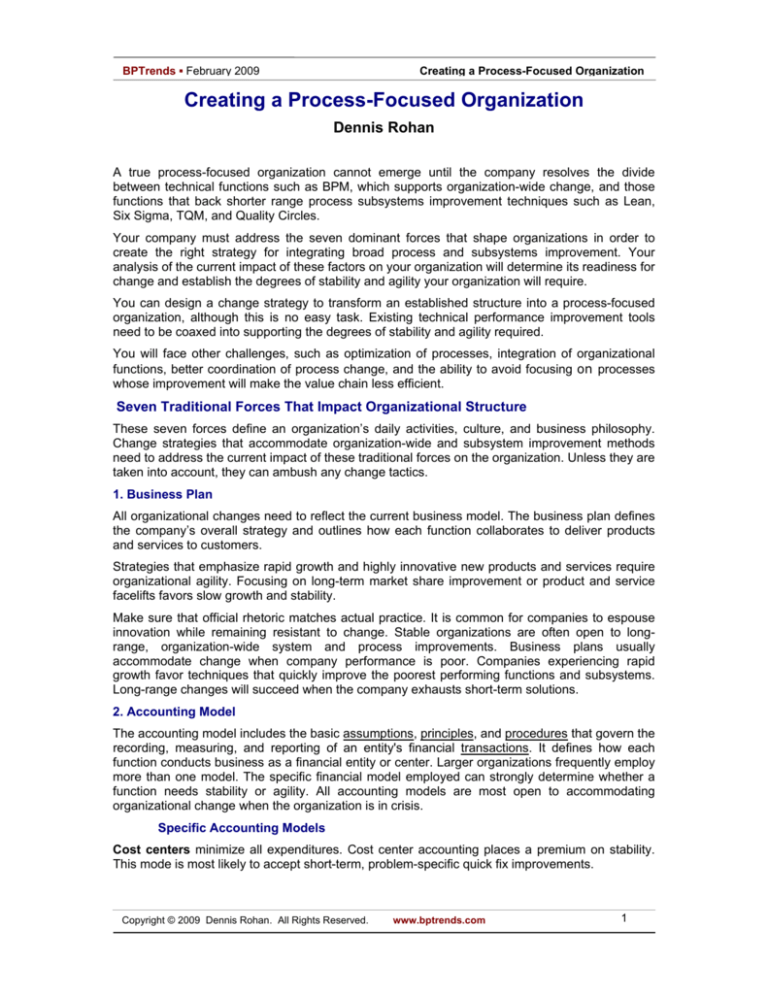
BPTrends ▪ February 2009
Creating a Process-Focused Organization
Creating a Process-Focused Organization
Dennis Rohan
A true process-focused organization cannot emerge until the company resolves the divide
between technical functions such as BPM, which supports organization-wide change, and those
functions that back shorter range process subsystems improvement techniques such as Lean,
Six Sigma, TQM, and Quality Circles.
Your company must address the seven dominant forces that shape organizations in order to
create the right strategy for integrating broad process and subsystems improvement. Your
analysis of the current impact of these factors on your organization will determine its readiness for
change and establish the degrees of stability and agility your organization will require.
You can design a change strategy to transform an established structure into a process-focused
organization, although this is no easy task. Existing technical performance improvement tools
need to be coaxed into supporting the degrees of stability and agility required.
You will face other challenges, such as optimization of processes, integration of organizational
functions, better coordination of process change, and the ability to avoid focusing on processes
whose improvement will make the value chain less efficient.
Seven Traditional Forces That Impact Organizational Structure
These seven forces define an organization’s daily activities, culture, and business philosophy.
Change strategies that accommodate organization-wide and subsystem improvement methods
need to address the current impact of these traditional forces on the organization. Unless they are
taken into account, they can ambush any change tactics.
1. Business Plan
All organizational changes need to reflect the current business model. The business plan defines
the company’s overall strategy and outlines how each function collaborates to deliver products
and services to customers.
Strategies that emphasize rapid growth and highly innovative new products and services require
organizational agility. Focusing on long-term market share improvement or product and service
facelifts favors slow growth and stability.
Make sure that official rhetoric matches actual practice. It is common for companies to espouse
innovation while remaining resistant to change. Stable organizations are often open to longrange, organization-wide system and process improvements. Business plans usually
accommodate change when company performance is poor. Companies experiencing rapid
growth favor techniques that quickly improve the poorest performing functions and subsystems.
Long-range changes will succeed when the company exhausts short-term solutions.
2. Accounting Model
The accounting model includes the basic assumptions, principles, and procedures that govern the
recording, measuring, and reporting of an entity's financial transactions. It defines how each
function conducts business as a financial entity or center. Larger organizations frequently employ
more than one model. The specific financial model employed can strongly determine whether a
function needs stability or agility. All accounting models are most open to accommodating
organizational change when the organization is in crisis.
Specific Accounting Models
Cost centers minimize all expenditures. Cost center accounting places a premium on stability.
This mode is most likely to accept short-term, problem-specific quick fix improvements.
Copyright © 2009 Dennis Rohan. All Rights Reserved.
www.bptrends.com
1
BPTrends ▪ February 2009
Creating a Process-Focused Organization
Profit centers optimize earnings. These models are open to longer-range solutions and some
organization-wide innovations.
Revenue centers maximize revenue generation. These centers have high-risk tolerance, and
revere agility. Revenue centers are not interested in techniques that do not raise revenues
quickly.
Return on assets centers maximize how efficiently management can generate profits from
available assets. These accounting centers recognize the need for balance between agility and
stability. They are open to both long-range and short-term solutions.
3. Organization Structure
There are five classic models that organizations use. Most enterprises are a hybrid of two or
more.
A. Functional Type: A Functional type is organized into components made up of people with
similar skills who perform the same function. Management is hierarchical. Functional
organizations encourage stability. Multiple levels of management, bureaucracy, and non-porous
functional silos present obstacles to building a process-focused organization. Large-scale
process change is best initiated by executive directive and initiative. The best opportunity for
change occurs when the organization realizes it has entered a state of inertia.
B. Project Type: In a Project type organization, the majority of people and resources are
assigned to completing projects. Management is hierarchical but fewer levels are required than in
the Functional type. These are agile structures. The best opportunities for process improvement
are usually found in accelerating project completion with fewer people, on budget and on time.
C. Matrix Type: Matrix type enterprises are a blend of functional stability and project agility. The
levels of management typically exceed those found in project type organizations. Functional
entities provide resources to the project groups. Matrix structures do not normally function well
when they need a long chain of consistent activities, coordinated handoffs, and highly responsive
supporting functions to produce products and services. Project type firms often flirt with the matrix
to add stability to project groups without compromising agility. This is a difficult balance to
maintain. The best opportunity for change is when management determines that the functions are
not fulfilling their supporting roles and project groups are spinning out of control.
D. Entrepreneurial Type: Entrepreneurial type organizations are the most agile firms and have
the leanest management structure. They are flat and fast moving. These organizations excel at
innovation and growth. Few have established disciplined approaches to performance
improvement. The best opportunities to introduce a long-range short-term process-focused
approach occur when growth and complexity force management to consider other forms of
organization.
E. Process Type: Process-focused organizations design and manage end-to-end processes
rather than tasks, measure process results rather than department efficiencies, and think in terms
of the customer and related goals rather than functional goals. Process-focused structures rarely
occur organization-wide and are usually subordinate to one of the other models. The level of
agility and stability is therefore determined by the dominant form of organization. Enterprises
dominated by their functional components require stable, process-focused entities and methods.
Project and matrix type organizations are best served by a process model that provides both
stability and agility. Entrepreneurial type organizations require agile processes. A growing
entrepreneurial enterprise provides an excellent opportunity to create a process-dominated
structure that provides both agility and stability. The ideal time to build focused entities in any
organization is when management is convinced that the current form has failed badly and other
non-process types are too risky to attempt.
Copyright © 2009 Dennis Rohan. All Rights Reserved.
www.bptrends.com
2
BPTrends ▪ February 2009
Creating a Process-Focused Organization
4. Culture: Technology versus Business
Culture clashes are not inevitable. However, willing cooperation requires that both sides
accommodate change. Technological people fall in love with their tools, which can result in overelegant solutions and evangelistic application of technology. The business side will view these
excesses as frustrating and wasteful. For its part, the business side is inclined to resist changes
that do not produce quick wins, and it needs to accept longer-range solutions. In organizations
where finance or technology dominates the culture, a top-down approach works well. Where
business side cultures prevail, technological changes are best achieved by bottom-up methods.
5. Technological Process Improvement Systems and Subsystems
Organizations with strong commitments to technological support functions are most open to
evolving into process-focused entities. Enterprises with large investments in business side
subsystems performance improvement technologies require sustained effort to become processfocused. The strengths of both sides need to be accommodated in order for organizational
change strategies to be effective.
6. Collaboration and Alliances
Interpersonal cooperation based on trust, enthusiasm, and security will produce quick wins.
Large-scale organizational changes require the creation of problem-solving teams that provide
the stability and agility needed to enable technology. These teams must include people with the
best natural ability to produce the comprehensive solutions required to create a process-focused
organization. Problem-solving supported by alliances and cooperation among groups is
necessary to integrate system-wide and subsystem solutions. Counter intuitively, natural talent
based teams form the strongest interpersonal alliances and collaboration networks. Problemsolving teams are better suited to support radical change than interpersonal teams.
7. Regulatory Influences
All organizations are subject to unexpected shifts in regulatory compliance demands. Staying
current with regulatory compliance requirements can prevent derailing change efforts.
Is Your Organization Ready for Change?
Determine which two of the seven forces impact your organization the most. To be successful,
your process-focused organization needs to accommodate the best benefits these two forces
provide. Most dominant organization factors will allow change when deteriorating financial
conditions force management to consider alternatives.
In spite of vastly improved efficiencies resulting from advances in technology, most organizations
look the same as their predecessors did before the scientific management and digital revolutions.
Converting traditional organizations to post-industrial, process-focused enterprises is not easy.
Imposing change on an organization that is not ready makes the existing structure value chain
less efficient.
Are You Ready for Change?
You need to be ready for change. Before starting to transform your organization, ask yourself
these questions. If you answer no to two or more items, consider delaying your plans until
conditions improve.
1. Are you prepared to expend the required levels of commitment and effort?
2. Do you have the cross-functional alliances to pull it off?
3. Are you prepared to allocate adequate current resources?
Copyright © 2009 Dennis Rohan. All Rights Reserved.
www.bptrends.com
3
BPTrends ▪ February 2009
Creating a Process-Focused Organization
4. Are you prepared to acquire the necessary additional resources?
5. Do you have support from management at least two levels above your immediate
supervisor?
Some Final Thoughts
When possible, build dominant force methods and structures into your process-focused model.
Be ready to accommodate the demand for short-term subsystem improvement methods.
Organizations are most open to radical change when they are financially challenged. Finally, the
three most important determinants of successful organizational change are timing, timing, and
timing.
Copyright © 2009 Dennis Rohan. All Rights Reserved.
www.bptrends.com
4

